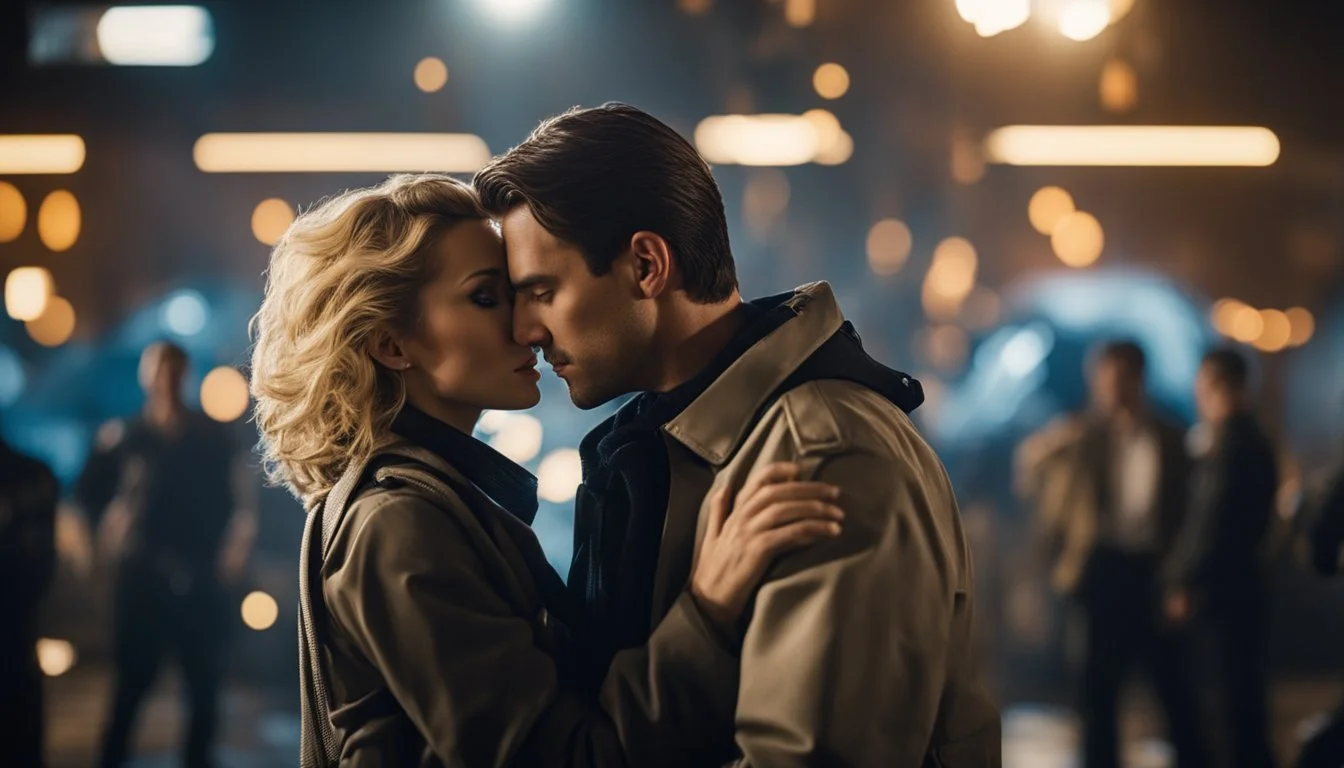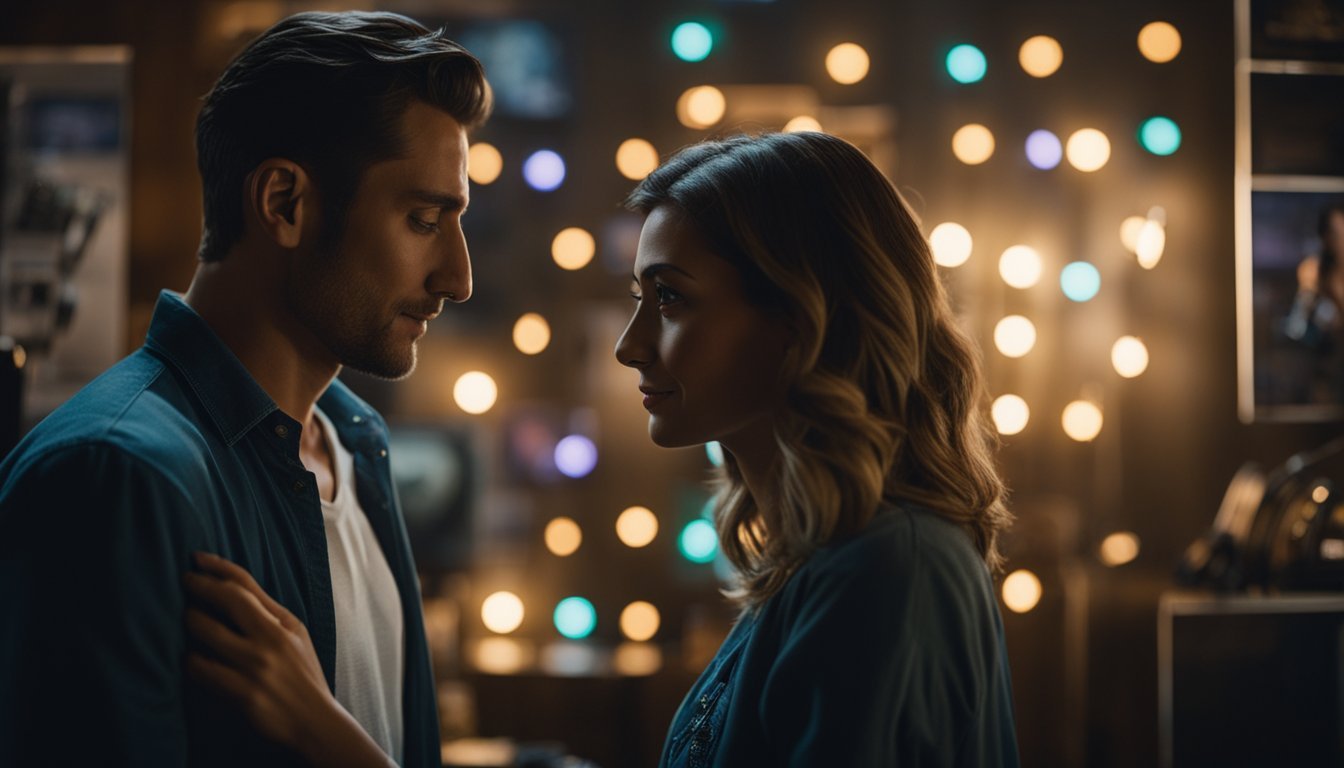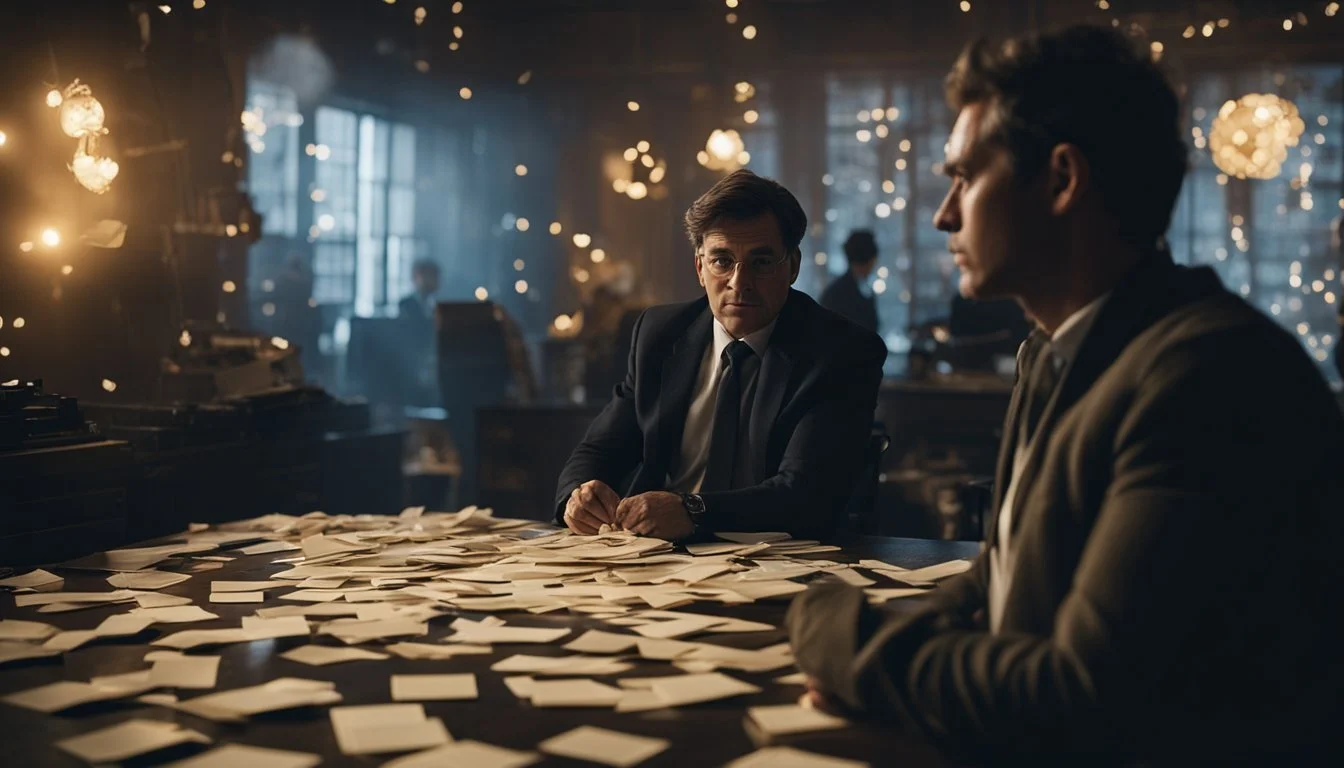Crazy Love Documentary Explores Intersection of Passion Crime and Filmmaking
The 2007 documentary "Crazy Love" explores the tumultuous relationship between Burt Pugach and Linda Riss. Their story began in 1957 when Pugach became infatuated with Riss, setting off a chain of events that would shock and captivate audiences decades later.
Directed by Dan Klores and Fisher Stevens, "Crazy Love" delves into the dark side of obsession and the complexities of human relationships. The film chronicles the infamous crime that occurred in 1959 when Pugach, unable to accept Riss's rejection, hired thugs to throw lye in her face, permanently blinding and scarring her.
Despite this horrific act, the story takes an unexpected turn. After Pugach's release from prison, he and Riss eventually married, remaining together for over three decades. This twist challenges viewers' perceptions of love, forgiveness, and the human psyche, making "Crazy Love" a compelling exploration of a truly unconventional romance.
Contextualizing 'Crazy Love'
'Crazy Love' emerged in a vibrant era of documentary filmmaking, challenging audiences with its complex portrayal of a tumultuous relationship. The film's directors brought unique perspectives to the project, shaping its narrative and visual style.
Cinematic Landscape at the Time of Release
'Crazy Love' debuted at the 2007 Sundance Film Festival, a period marked by renewed interest in documentary storytelling. The film industry was experiencing a surge in non-fiction narratives that blurred the lines between entertainment and journalism. 'Crazy Love' stood out for its unflinching examination of a controversial romance, aligning with audience appetites for true crime stories and complex character studies.
The documentary landscape was shifting towards more personal, character-driven narratives. This trend allowed 'Crazy Love' to delve deep into the psyche of its subjects, offering an intimate look at a relationship that defied conventional understanding.
The Impact of Dan Klores and Fisher Stevens in Documentary Filmmaking
Dan Klores and Fisher Stevens brought distinct strengths to 'Crazy Love'. Klores, known for his journalistic background, provided a meticulous approach to research and storytelling. His experience as a publicist gave him unique insights into crafting compelling narratives.
Stevens, an actor and producer, contributed his understanding of dramatic structure and character development. Their collaboration resulted in a film that balanced factual accuracy with cinematic flair.
The directors' approach to 'Crazy Love' influenced subsequent documentaries. They demonstrated how to handle sensitive subject matter with nuance, avoiding sensationalism while maintaining audience engagement. Their work helped elevate the true crime genre beyond mere shock value.
Profiles of the Protagonists
Burt Pugach and Linda Pugach were at the center of a shocking true crime story that captivated New York and the nation. Their complex relationship spanned decades, marked by obsession, violence, and an unexpected reconciliation.
Burt Pugach: A Deep Dive Into His Life and Persona
Burt Pugach was a Bronx-born lawyer with a troubled past. His obsessive personality manifested early in life, leading to a series of romantic entanglements.
Pugach's legal career was marred by unethical practices and fraud charges. His fixation on Linda Riss led to his most notorious crime: orchestrating an acid attack that left her blind.
After serving 14 years in prison, Pugach remarketed himself as a contrite ex-convict. He wrote a book about his experiences and appeared on talk shows.
Pugach's ability to charm and manipulate others remained a defining trait throughout his life. His pursuit of Linda, even after his release, demonstrated his unwavering obsession.
Linda Pugach: Understanding the Woman Behind the Victim
Linda Riss, later Linda Pugach, was a young beauty from East New York when she first met Burt. Her life took a dramatic turn after rejecting his advances.
The acid attack left Linda blind and scarred, both physically and emotionally. She faced a long recovery process and struggled with depression.
Despite the trauma inflicted by Burt, Linda agreed to marry him after his release from prison. This decision shocked many and raised questions about Stockholm syndrome.
Linda maintained a complex relationship with Burt, alternating between defending him and expressing regret. She became an advocate for victims of domestic violence.
Her resilience in the face of adversity was remarkable. Linda adapted to her blindness and pursued various interests, including writing and public speaking.
The Nexus of Love and Crime
Love and crime intertwine in the shocking true story of Burt Pugach and Linda Riss. Their tumultuous relationship blurred the lines between passion and violence, captivating the public's attention for decades.
Exploring the Nature of the Relationship Between Burt and Linda
Burt Pugach and Linda Riss met in 1957 in New York City. Their romance quickly intensified, but complications arose due to Burt's existing marriage. Linda, unaware of his marital status, became entangled in a web of deception.
Burt's obsession with Linda grew increasingly apparent. He showered her with gifts and promises of marriage. However, when Linda discovered the truth about his wife, she ended the relationship.
Burt's reaction to the breakup revealed a darker side. He began stalking Linda and making threats. His behavior escalated from unwanted attention to dangerous actions.
The Crime of Passion That Shocked the World
In 1959, Burt's obsession reached a horrifying climax. He hired three men to attack Linda with lye, permanently disfiguring and blinding her. This act of violence stunned the public and became a tabloid sensation.
The subsequent trial captivated the nation. Burt was found guilty and sentenced to 30 years in prison. Linda's life was forever altered by the attack, leaving her scarred both physically and emotionally.
In a twist that defied expectations, Linda married Burt after his release from prison in 1974. Their unconventional union raised questions about the nature of love, forgiveness, and the long-term effects of trauma.
Production and Storytelling Techniques
"Crazy Love" employs unique narrative approaches and documentary techniques to tell its complex story. The film blends archival footage, interviews, and creative editing to craft a compelling portrait of obsession and reconciliation.
Narrative Construction in 'Crazy Love'
The documentary weaves together multiple timelines to build suspense and reveal key plot points. Archival photographs and news footage establish the historical context of Burt and Linda's relationship. The filmmakers use carefully selected clips to highlight pivotal moments in their tumultuous history.
Reenactments sparingly recreate certain scenes, adding visual interest without overshadowing the real-life testimonies. The non-linear structure allows the story to unfold gradually, keeping viewers engaged as new details emerge. This approach mirrors the complex nature of Burt and Linda's relationship, reflecting its ups and downs over decades.
Innovative Use of Interviews in the Documentary
Interviews form the backbone of "Crazy Love," offering firsthand accounts from the main subjects and those close to them. The filmmakers employ a mix of talking-head interviews and more casual, conversational segments. This variety helps maintain visual interest and pacing throughout the film.
Burt and Linda's interviews are conducted separately and together, providing multiple perspectives on key events. The documentary also features interviews with friends, family members, and legal experts. These additional voices offer context and sometimes conflicting views, adding depth to the narrative.
The interviewers' questions are often edited out, creating a more immersive experience for viewers. This technique allows the subjects' stories to flow naturally, enhancing the emotional impact of their testimonies.
Themes and Human Emotions
'Crazy Love' explores the intricate tapestry of human emotions and relationships. The film delves into the complexities of love, obsession, and forgiveness, revealing the often irrational nature of human behavior.
Dissecting the Themes of Passion, Obsession, and Forgiveness
Passion drives the narrative of 'Crazy Love', manifesting in both destructive and transformative ways. The film portrays obsession as a dark extension of love, blurring the lines between devotion and dangerous fixation.
Burt Pugach's intense feelings for Linda Riss exemplify this theme. His actions, while extreme, stem from a place of deep-seated emotional attachment.
Forgiveness emerges as a powerful force in the latter part of the story. Linda's ability to forgive Burt challenges viewers' perceptions of love and redemption.
The film raises questions about the limits of forgiveness and the capacity for change in human relationships.
Human Nature: A Look at the Fundamental Emotions Displayed
'Crazy Love' offers a raw look at human nature through its portrayal of basic emotions. Fear, anger, and desire play pivotal roles in shaping the characters' decisions and actions.
Burt's behavior is driven by primal feelings of jealousy and possessiveness. These emotions override rational thought, leading to his bizarre and criminal actions.
Linda's journey showcases a range of emotions from initial attraction to terror and eventually, a form of acceptance. Her emotional evolution reflects the complexity of human nature.
The film illustrates how emotions can both unite and divide people, highlighting the unpredictable nature of human relationships. It challenges viewers to examine their own emotional responses and capacity for empathy.
The Legal and Societal Aftermath
The legal proceedings and public response following the crime and reunion of Burt and Linda Pugach shaped perceptions of love, justice, and mental health. Their case became a media sensation that challenged societal norms.
Court Proceedings and the Role of the Legal System
Burt Pugach faced trial for the acid attack on Linda Riss in New York. He was found guilty and sentenced to 15-30 years in prison. The court deemed his actions premeditated and rejected claims of temporary insanity.
During his incarceration, Pugach made multiple attempts for parole. Each hearing brought renewed media attention to the case. After serving 14 years, he was released on parole in 1974.
Legal debates arose around Linda's decision to marry Burt after his release. Some questioned if Stockholm syndrome or coercion played a role. The courts ultimately recognized their union as legally valid.
Public Perception and Media Coverage
The Pugach case became a tabloid sensation. Newspapers and television shows eagerly covered each development. Public opinion was sharply divided on the couple's relationship.
Many viewed Burt as a dangerous criminal who manipulated his victim. Others saw a twisted but genuine love story. Linda's choice to marry Burt baffled and fascinated the public.
The media portrayed their relationship as both romantic and disturbing. Talk shows and documentaries dissected their dynamic. The case sparked discussions on domestic violence, forgiveness, and the nature of love.
Their story challenged societal norms about relationships and redemption. It forced people to confront uncomfortable questions about the complexities of human emotions and behavior.
Critical Reception and Legacy
'Crazy Love' sparked intense debates among critics and audiences, leaving a lasting impression on the documentary genre. Its provocative subject matter and unique storytelling approach challenged viewers' perceptions of love, justice, and forgiveness.
Analyzing Critics' Reviews and Audience Responses
Critics praised 'Crazy Love' for its compelling narrative and expert filmmaking. Many lauded the documentary's ability to present a complex, morally ambiguous story without judgment. Some reviewers, however, expressed discomfort with the film's subject matter.
Audience reactions were equally divided. Many viewers found themselves captivated by the shocking twists and turns of the Pugach-Riss relationship. Others criticized the film for potentially glamorizing abusive behavior.
The documentary's box office performance exceeded expectations for a niche film, indicating strong public interest in the story.
The Lasting Impact of 'Crazy Love' on Documentary Genre
'Crazy Love' influenced subsequent documentaries in several ways:
Narrative structure: It demonstrated the power of using a chronological storytelling approach in documentaries.
Subject matter: The film opened doors for more documentaries exploring unconventional relationships and true crime stories.
Visual style: Its blend of archival footage and contemporary interviews became a template for many future documentaries.
The film's success encouraged filmmakers to tackle controversial topics and push boundaries in documentary storytelling. It remains a reference point for discussions about ethics in documentary filmmaking and the portrayal of complex human relationships on screen.
Beyond 'Crazy Love': Related Works
Dan Klores, the director of 'Crazy Love', has created other compelling documentaries that explore complex relationships and human stories. His works often delve into themes of love, ambition, and societal issues.
Exploring Other Works by Dan Klores
Dan Klores has established himself as a skilled documentarian with a keen eye for unique human stories. His film 'The Boys of 2nd Street Park' (2003) chronicles the lives of a group of friends from Brighton Beach, Brooklyn over several decades. This documentary showcases Klores' ability to capture the essence of New York City and its inhabitants.
Klores also directed 'Ring of Fire: The Emile Griffith Story' (2005), which examines the life of boxer Emile Griffith. The film explores themes of sexuality, violence, and redemption in the world of professional boxing.
The Relevance of 'The Boys of 2nd Street Park' and 'Ring of Fire'
'The Boys of 2nd Street Park' shares similarities with 'Crazy Love' in its exploration of long-term relationships and the impact of time on human connections. The film follows a group of friends from their youth in the 1950s through adulthood, highlighting the changes in their lives and relationships.
'Ring of Fire' tackles complex themes similar to those in 'Crazy Love', including love, violence, and redemption. The film focuses on boxer Emile Griffith and the tragic fight that resulted in the death of his opponent, Benny Paret. This documentary showcases Klores' ability to handle sensitive subjects with nuance and depth.
Conclusion: The Complexities of 'Crazy Love
'Crazy Love' presents a captivating exploration of a tumultuous relationship that defies conventional understanding. The documentary sheds light on the intricate dynamics between Burt Pugach and Linda Riss, set against the backdrop of New York City.
Their story challenges preconceptions about love, forgiveness, and human behavior. The film raises thought-provoking questions about the nature of obsession and the lengths people go to for perceived love.
Through interviews and archival footage, 'Crazy Love' paints a nuanced picture of its subjects. It refrains from passing judgment, allowing viewers to form their own opinions about the events that unfold.
The documentary's strength lies in its ability to present a complex narrative without oversimplification. It navigates the fine line between sensationalism and empathy, offering a balanced portrayal of a relationship that spans decades.
'Crazy Love' serves as a mirror to human nature, reflecting our capacity for both compassion and cruelty. It prompts viewers to examine their own beliefs about love, justice, and second chances.
The film's impact extends beyond its subjects, encouraging broader discussions about societal norms and the justice system. It leaves audiences with lingering questions about the complexities of human relationships and the unpredictable nature of love.









